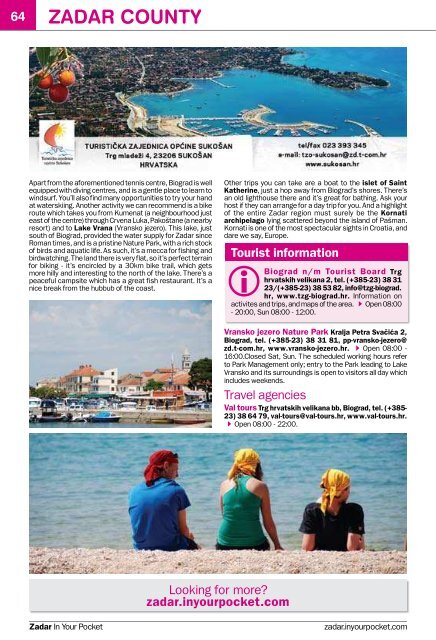Create successful ePaper yourself
Turn your PDF publications into a flip-book with our unique Google optimized e-Paper software.
64 Zadar county<br />
Zadar county<br />
65<br />
Apart from the aforementioned tennis centre, Biograd is well<br />
equipped with diving centres, and is a gentle place <strong>to</strong> learn <strong>to</strong><br />
windsurf. You’ll also find many opportunities <strong>to</strong> try your hand<br />
at waterskiing. Another activity we can recommend is a bike<br />
route which takes you from Kumenat (a neighbourhood just<br />
east of the centre) through Crvena Luka, Pakoštane (a nearby<br />
resort) and <strong>to</strong> Lake Vrana (Vransko jezero). This lake, just<br />
south of Biograd, provided the water supply for Zadar since<br />
Roman times, and is a pristine Nature Park, with a rich s<strong>to</strong>ck<br />
of birds and aquatic life. As such, it’s a mecca for fishing and<br />
birdwatching. The land there is very flat, so it’s perfect terrain<br />
for biking - it’s encircled by a 30km bike trail, which gets<br />
more hilly and interesting <strong>to</strong> the north of the lake. There’s a<br />
peaceful campsite which has a great fish restaurant. It’s a<br />
nice break from the hubbub of the coast.<br />
Other trips you can take are a boat <strong>to</strong> the islet of Saint<br />
Katherine, just a hop away from Biograd’s shores. There’s<br />
an old lighthouse there and it’s great for bathing. Ask your<br />
host if they can arrange for a day trip for you. And a highlight<br />
of the entire Zadar region must surely be the Kornati<br />
archipelago lying scattered beyond the island of Pašman.<br />
Kornati is one of the most spectacular sights in Croatia, and<br />
dare we say, Europe.<br />
Tourist information<br />
i<br />
Biograd n/m Tourist Board Trg<br />
hrvatskih velikana 2, tel. (+385-23) 38 31<br />
23/(+385-23) 38 53 82, info@tzg-biograd.<br />
hr, www.tzg-biograd.hr. Information on<br />
activites and trips, and maps of the area. QOpen 08:00<br />
- 20:00, Sun 08:00 - 12:00.<br />
Ancient Churches and Castles of<br />
Zadar County<br />
Like other regions of Croatia, Zadar County has a myriad<br />
of spectacular and fascinating castle ruins and ancient<br />
churches. Because it was the heart of the medieval Croatian<br />
kingdom, a key trading post and militarily important in<br />
controlling the northern Adriatic Sea, this region is particularly<br />
rich in castles and his<strong>to</strong>ry. For millennia, the area that is<br />
now Zadar County has been the front line in the struggles<br />
between various empires and ethnic groups: the Romans<br />
vs. the Visigoths, the Venetians vs. the Turks, the French vs.<br />
the Austro-Hungarians and most recently the Serbs vs. the<br />
Croats. Fortunately for the modern visi<strong>to</strong>r, the only struggle<br />
these days is deciding where <strong>to</strong> go sightseeing first! The sea,<br />
hilly islands and Velebit mountains add a dramatic backdrop<br />
<strong>to</strong> ancient buildings.<br />
If one starts in Zadar and proceeds on a clockwise circuit<br />
of the county, the first notable <strong>to</strong>wn encountered is Nin, 16<br />
kilometers north of Zadar on Route 306. It has the oldest<br />
church in Croatia, the tiny, Romanesque Church of the<br />
Holy Cross (Crkva sve<strong>to</strong>g Križa). An inscription on the lintel<br />
is dated 800 A.D. On the south side of Nin, just outside the<br />
<strong>to</strong>wn, is another tiny church, St. Nicholas’s (Crkva sve<strong>to</strong>g<br />
Nikole), which was built in the 11th century. Located on an<br />
ancient burial mound, it’s easy <strong>to</strong> spot. When the Ot<strong>to</strong>man<br />
Turks occupied this area in the mid-16th century they<br />
refortified St. Nicholas, adding the crenellated <strong>to</strong>p. It makes<br />
the church look like a miniature castle. After the Venetians<br />
drove the Turks out in the following century, St. Nicholas<br />
was refortified again.<br />
Looking for more?<br />
zadar.inyourpocket.com<br />
Vransko jezero Nature Park Kralja Petra Svačića 2,<br />
Biograd, tel. (+385-23) 38 31 81, pp-vransko-jezero@<br />
zd.t-com.hr, www.vransko-jezero.hr. QOpen 08:00 -<br />
16:00.Closed Sat, Sun. The scheduled working hours refer<br />
<strong>to</strong> Park Management only; entry <strong>to</strong> the Park leading <strong>to</strong> Lake<br />
Vransko and its surroundings is open <strong>to</strong> visi<strong>to</strong>rs all day which<br />
includes weekends.<br />
Travel agencies<br />
Val <strong>to</strong>urs Trg hrvatskih velikana bb, Biograd, tel. (+385-<br />
23) 38 64 79, val-<strong>to</strong>urs@val-<strong>to</strong>urs.hr, www.val-<strong>to</strong>urs.hr.<br />
QOpen 08:00 - 22:00.<br />
There are several spectacular castle ruins in Zadar County.<br />
Starigrad Ljubač, 15 kilometers due north of Zadar City, lies<br />
on a cliff above the sea and has a commanding view of Pag<br />
Island <strong>to</strong> the north. Templar knights are believed <strong>to</strong> have built<br />
Ljubač in the 13th century. The castle provided them with a<br />
clear view of anyone approaching by sea from the north or<br />
west. When the Turks invaded in the 16th century, the local<br />
inhabitants <strong>to</strong>ok shelter there. Later the castle featured<br />
prominently in battles between the Turks and the Venetians.<br />
As is usually the case, there are no signs indicating the way<br />
<strong>to</strong> this site. To reach Ljubač turn right at the Sonik grocery<br />
s<strong>to</strong>re in the middle of the village. Go 1.2 km up that road,<br />
then turn left (north) on a dirt road at the first giant antenna<br />
at the <strong>to</strong>p of the hill. Follow that dirt road <strong>to</strong> Ljubač. It’s about<br />
a 45 minutes walk on undulating terrain. It’s not advisable<br />
<strong>to</strong> drive unless you have a sport utility vehicle, in which it<br />
would take 15 - 20 minutes. Not <strong>to</strong>o far from Ljubač, on the<br />
southern tip of Pag, is another precariously situated castle<br />
fortress called Fortica. Built by the Venetians in the 16th<br />
century, it’s just below the bridge from the mainland <strong>to</strong> Pag,<br />
guarding the strait below. It matches the color of Pag’s barren<br />
landscape. You can easily reach the Fortica from Ljubač.<br />
The two are visible from each other, making one speculate<br />
what rivalries or alliances between their occupants might<br />
have existed over the centuries. Alternatively, you can get<br />
<strong>to</strong> Fortica by going north <strong>to</strong>wards the <strong>to</strong>wn of Pag on route<br />
106 from the Posedarje exit on the A1 mo<strong>to</strong>rway. Novigrad<br />
(literally “New Town”, somewhat of a misnomer), a castle<br />
ruin perched on a hill above the <strong>to</strong>wn of the same name,<br />
also has had a turbulent his<strong>to</strong>ry. The Romans, and before<br />
them, the Liburnians, built forts on the same spot. Some of<br />
the walls date from Roman times, but Novigrad has been<br />
modernized. It has several restaurants and cafes right on<br />
the water, offering nice views of the harbor. Located 31 km<br />
east of Zadar via route 502, Novigrad has been the front<br />
line in several conflicts. During dynasty wars (1385-1387)<br />
in what is now Croatia, two woman of royalty, Mary, the wife<br />
of Croatian-Hungarian King Sigismund Luxemberg, and her<br />
mother, Elizabeth, were murdered there. During the Kandian<br />
Wars (1645-1669) it was an important point of Venice’s<br />
defense against the Turks, who occupied the <strong>to</strong>wn during<br />
1646-47. When the Venetians re<strong>to</strong>ok the <strong>to</strong>wn the castle<br />
was substantially destroyed. During the more recent war of<br />
1991-1995 after the break up of Yugoslavia, the Serbs also<br />
held the <strong>to</strong>wn for two years. There is another spectacular<br />
view of the modern day <strong>to</strong>wn and the sea from the ruins,<br />
which are accessible from several trails. The easiest <strong>to</strong> find<br />
(again, no signs!) starts from the <strong>to</strong>p of some wide stairs that<br />
ascend from the east side of <strong>to</strong>wn. Go right at the <strong>to</strong>p of the<br />
stairs and then left after about 10 meters. It takes around<br />
10 - 15 minutes <strong>to</strong> reach the castle. Obrovac is another<br />
hill <strong>to</strong>p castle/fortress above a modern day <strong>to</strong>wn of the<br />
same name. You can reach this small <strong>to</strong>wn easily from the<br />
Maslenica exit on the main Zagreb - Split highway, A1. There<br />
are plenty of eateries and cafes in Obrovac. It takes about<br />
10-15 minutes <strong>to</strong> ascend the steep hill from the middle of<br />
<strong>to</strong>wn <strong>to</strong> the castle. The stately Velebit<br />
www.inyourpocket.com<br />
Zadar In Your Pocket<br />
zadar.inyourpocket.com<br />
zadar.inyourpocket.com<br />
Summer 2011







